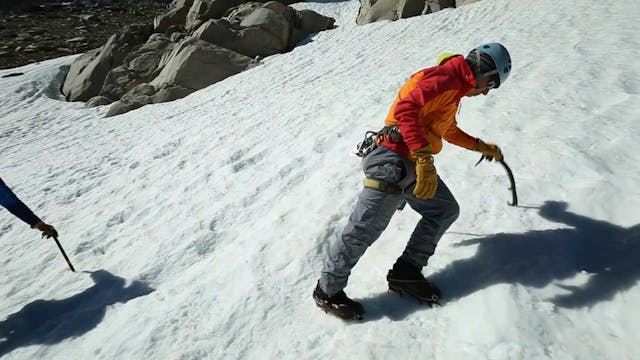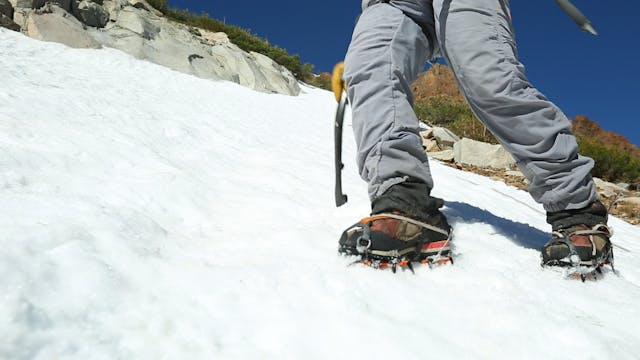Alpine: 7. Efficient Snow Travel
Alpine & Mountaineering
•
1m 55s
When getting into mountaineering, it is worth it to invest time in learning and practicing the most efficient stepping techniques. Mountains can be huge, and involve lots of steps. The more efficient you are with each one, the further you will be able to climb.
As the saying goes: how do you eat an elephant? One bite at a time. To climb big mountains, take one step at a time.
1. The Rest Step - This is a fundamental technique in mountaineering. Straighten your downhill leg and allow your body weight to rest on your skeleton. This allows your breathing to stay at a slower respiratory rate and your muscles to stay in a lower work output.
If you can get into a rest step rhythm, you will keep your body at an overall lower workload.
2. Switchbacking - climb along diagonal lines, much like switchbacking on trails—but on snow, you make your own trail! This will reduce the high energy demands of tackling a steep fall line. Compare switchbacking vs. ascending straight on with front pointing.
3. Crossover step - For this, your downhill foot will move uphill and your legs will be crossed in an “out of balance” step. The next step will uncross your legs, which will put you in an “in balance” step. Keep your ice axe in the uphill hand, but only move it ahead of you when you are in the “in balance” step. This allows you to always have two points of contact with the snow, and ensures that you only move your ice axe when you are standing “in balance.”
If you are switchbacking up the snow, you will need to change directions eventually. This can be awkward and feel exposed, so it is important to use good technique. For more on this, see our next video on “Changing Directions in Snow”.
Editor’s Note:
Some of the videos in this Alpine & Mountaineering series have footage of “short roping”, when one person is out in front of the other person, with about 8 feet of rope in between the two climbers. This technique is specific to guiding, and should not be used by the general public. It takes training, and an awareness of specific conditions where it is appropriate. Short roping terrain is typically something recreational climbers might solo. Ropes only come out for steep or exposed terrain, or for glacier travel.
We hope you found this video helpful. Feel free to comment below with questions or thoughts!
Please remember, climbing is inherently dangerous. Climb at your own risk.
Up Next in Alpine & Mountaineering
-
Alpine: 8. Changing Directions in Snow
Let’s look at how to change directions when climbing steep snow slopes. When switchbacking up a steep snow slope, you will obviously have to change directions—multiple times!
Here are the steps for changing direction, while maintaining a self belay with the ice axe for security:
Step 1: Ta...
-
Alpine: 9. Crampon Anti-Balling Plates
In this video we discuss crampon anti-balling plates. Snow can stick to the bottom of your crampons, especially in wet snow conditions. After a few steps, you’ll feel like you’re walking on slippery (and heavy) platform shoes, and your sharp points will be useless.
One solution that manufactur...
-
Alpine: 10. Descending on Snow
In this video we look at descent techniques on snow. Investing time to become comfortable and efficient while descending snow helps you become faster on big mountain routes. People who ski or snowboard are likely familiar with a key component of the technique: keeping a confident, athletic positi...


